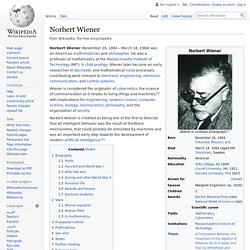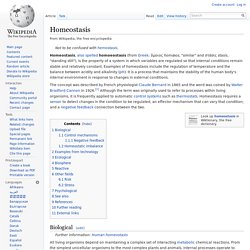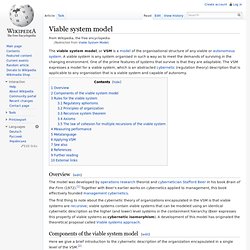

William Ross Ashby. W.

Ross Ashby (London, 6 September 1903 – 15 November 1972) was an English psychiatrist and a pioneer in cybernetics, the study of complex systems. His first name was not used: he was known as Ross Ashby. His two books, Design for a Brain and An Introduction to Cybernetics, were landmark works. They introduced exact and logical thinking into the nascent discipline and were highly influential. Biography[edit] William Ross Ashby was born in 1903 in London, where his father was working at an advertising agency.[1] From 1917 to 1921, William studied at the Edinburgh Academy in Scotland, and from 1921 at Sidney Sussex College, Cambridge, where he received his B.A. in 1924 and his M.B. and B.Ch. in 1928.
Ross Ashby started working in 1930 as a Clinical Psychiatrist in the London County Council. When he returned to England, he served as Director of Research of the Barnwood House Hospital in Gloucester from 1947 until 1959. On 4–6 March 2004, a W. Anthony Stafford Beer. Stafford Beer (25 September 1926 – 23 August 2002) was a British theorist, consultant and professor at the Manchester Business School.

He is best known for his work in the fields of operational research and management cybernetics. Biography[edit] Beer was born in London in 1926. He started a degree in philosophy at University College London, but left in 1944 to join the army. He saw service in India and stayed there until 1947. He joined United Steel and persuaded the management to found an operational research group, the Department of Operations Research and Cybernetics, which he headed. In mid-1971, Beer was approached by Fernando Flores, then a high-ranking member of the Chilean Production Development Corporation (CORFO) in the newly elected socialist government of Salvador Allende, for advice on applying his cybernetic theories to the management of the state-run sector of the Chilean economy. He was married twice, in 1947 to Cynthia Hannaway and in 1968 to Sallie Steadman.
Norbert Wiener. Norbert Wiener (November 26, 1894 – March 18, 1964) was an American mathematician and philosopher.

He was Professor of Mathematics at MIT. A famous child prodigy, Wiener later became an early researcher in stochastic and noise processes, contributing work relevant to electronic engineering, electronic communication, and control systems. Wiener is considered the originator of cybernetics, a formalization of the notion of feedback, with implications for engineering, systems control, computer science, biology, neuroscience, philosophy, and the organization of society. Biography[edit] Youth[edit] Wiener was born in Columbia, Missouri, the first child of Leo Wiener and Bertha Kahn, Jews[1] of Polish and German origin, respectively. Despite being raised in a Jewish family, he later became an agnostic.[2] After graduating from Ayer High School in 1906 at 11 years of age, Wiener entered Tufts College.
Harvard and World War I[edit] After the war[edit] During and after World War II[edit] The Law of Requisite Variety. Homeostasis. Homeostasis, also spelled homoeostasis (from Greek: ὅμοιος homœos, "similar" and στάσις stasis, "standing still"), is the property of a system in which variables are regulated so that internal conditions remain stable and relatively constant.

Examples of homeostasis include the regulation of temperature and the balance between acidity and alkalinity (pH). It is a process that maintains the stability of the human body's internal environment in response to changes in external conditions. The concept was described by French physiologist Claude Bernard in 1865 and the word was coined by Walter Bradford Cannon in 1926.[1] Although the term was originally used to refer to processes within living organisms, it is frequently applied to automatic control systems such as thermostats. Homeostasis requires a sensor to detect changes in the condition to be regulated, an effector mechanism that can vary that condition; and a negative feedback connection between the two. TheViableSystemModel.pdf. Viable System Model. Overview[edit] The model was developed by operations research theorist and cybernetician Stafford Beer in his book Brain of the Firm (1972).[1] Together with Beer's earlier works on cybernetics applied to management, this book effectively founded management cybernetics.

The first thing to note about the cybernetic theory of organizations encapsulated in the VSM is that viable systems are recursive; viable systems contain viable systems that can be modeled using an identical cybernetic description as the higher (and lower) level systems in the containment hierarchy (Beer expresses this property of viable systems as cybernetic isomorphism). A development of this model has originated the theoretical proposal called Viable systems approach. Components of the viable system model[edit] Here we give a brief introduction to the cybernetic description of the organization encapsulated in a single level of the VSM.[2] Principal functions of the VSM Rules for the viable system[edit] These aphorisms are: